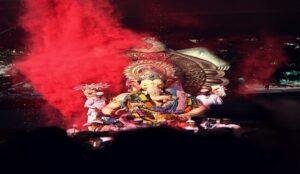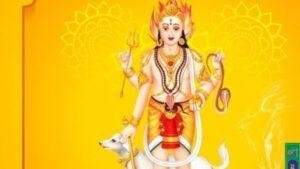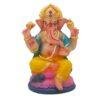The Maa Kamakhya Temple in Assam, India, is a truly captivating and ancient place. It sits atop a hill called Nilachal, surrounded by stunning natural beauty. This temple holds immense significance as it is dedicated to the highly revered Goddess Kamakhya in the Hindu religion.
The history of this temple dates back many centuries, making it one of the oldest and most sacred sites in the region. People from distant places believe in its divine power and make long journeys to visit and offer prayers.
The temple’s design is exceptionally unique and adorned with intricate carvings and sculptures, showcasing the remarkable skills of its builders. Its fusion of different architectural styles renders it a mesmerizing and unforgettable sight.
Throughout the year, countless devotees throng to the temple to express their unwavering faith and marvel at its beauty. Among the most famous events held here is the Ambubachi Mela, a grand festival brimming with special rituals and joyous celebrations.
Even after all these years, the Maa Kamakhya Temple has retained its ancient charm and remains an integral part of the local culture. It serves as a sanctuary where people find solace and forge a spiritual connection. The enthralling stories and legends surrounding the temple add an air of mystery, making it a treasured destination for both locals and tourists.
This article will explore the Maa Kamakhya Temple’s enthralling past, magnificent architecture, enthralling mythology, happy celebrations, and the temple’s profound relevance in the modern world. It is a magical, spiritual location that leaves a lasting impression on everyone who has the opportunity to come.
Architectural Marvels of Maa Kamakhya Temple
The Maa Kamakhya Temple, located atop the Nilachal Hill in Guwahati, Assam, is renowned for its unique and awe-inspiring architectural marvels. The temple’s architecture reflects a blend of different styles and features that have evolved over centuries. Here are some of the key architectural marvels of the Maa Kamakhya Temple:
1. Unique Blend of Architectural Styles:
The Maa Kamakhya Temple showcases a fascinating fusion of architectural styles, including Hindu and tantric elements. The temple’s main structure, known as the Garbhagriha or sanctum sanctorum, follows the traditional Hindu temple architecture with its pyramidal shikhara (spire) and mandapa (hall) layout. However, the temple also incorporates unique tantric elements that set it apart from other Hindu temples in India.
2. Intricate Carvings and Sculptures:
The temple is adorned with intricate carvings and sculptures, depicting various deities, mythological scenes, and tantric symbols. The exterior of the temple features elaborate artwork of gods, goddesses, animals, and floral motifs. The inner sanctum walls bear depictions of the 10 Mahavidyas, which are ten forms of the goddess Devi, including Kamakhya herself.
3. Unique Roof Architecture:
The temple’s roof is a remarkable sight in itself. It is covered with multiple golden spires or shikharas, giving it a distinctive and resplendent appearance. The shikharas, adorned with intricate motifs, contribute to the temple’s overall grandeur.
4. Ambulatory Pathway (Pradakshina):
Surrounding the main temple complex is an ambulatory pathway known as the Pradakshina path. The path takes devotees around the temple and offers them glimpses of smaller shrines and idols placed at strategic points. This design allows for a seamless flow of devotees during religious processions and festivals.
5. Yoni and Kamakhya Symbology:
One of the most unique features of the Maa Kamakhya Temple is the presence of a stone yoni (female reproductive organ) within the sanctum sanctorum. This yoni is covered with a natural spring, symbolizing the menstruating goddess. The temple’s association with fertility and feminine energy makes it a sacred place for tantric rituals and worship.
6. Water Reservoirs and Ancient Tanks:
The temple complex features several ancient tanks and water reservoirs that were designed to ensure a consistent water supply for various rituals and ceremonies. These tanks also serve as a significant water conservation system.
7. Axial Alignment and Vastu Principles:
The temple is meticulously designed with precise axial alignment and follows Vastu Shastra principles, an ancient Indian system of architecture. The layout and positioning of the temple are believed to be in harmony with cosmic forces and the environment.
8. Stambhas (Pillars) and Mandapas:
The temple complex contains a series of intricately carved pillars and mandapas, providing support to the structure and adding to its artistic beauty. These pillars often have mythological stories depicted on them.
The architectural marvels of the Maa Kamakhya Temple not only attract devotees but also intrigue scholars, architects, and tourists from around the world. The unique blend of religious, tantric, and artistic elements makes the temple a truly mystical wonder and a significant symbol of Assam’s rich cultural heritage.
The Mystique and Legends Surrounding Maa Kamakhya
Unveiling the Mysteries of Maa Kamakhya as follows:-
1. The Tale of Kamakhya Devi’s Birth:
In ancient Hindu stories, Maa Kamakhya’s origin is connected to Sati, the first wife of Lord Shiva. Sati’s father, King Daksha, held a grand yagna but didn’t invite Shiva, causing Sati immense pain. She attended the yagna against Shiva’s wishes and was humiliated by her father.
Heartbroken, Sati immolated herself in the sacred fire. Shiva, in fury, carried her charred body and threatened to destroy the world with his dance. To prevent disaster, Lord Vishnu used his divine weapon to scatter Sati’s body parts. It is believed that Sati’s yoni (female genitalia) fell at the site of today’s Kamakhya Temple.
2. The Goddess’s Special Time:
One intriguing aspect of the Kamakhya Temple is the belief that the goddess menstruates during the Ambubachi Mela, an annual June festival. The temple remains closed for three days, and it is thought that the goddess undergoes her menstrual cycle. The nearby Brahmaputra River’s water turns red, symbolizing her menstruation. Devotees view this as sacred, representing the goddess’s fertility and life-giving powers.
3. Tantra Practices and Kamakhya:
The Kamakhya Temple is closely connected with Tantric practices, making it a significant center for Tantra worship in India. Tantra, a mystical branch of Hinduism, uses rituals, mantras, and sacred diagrams to channel divine energy for spiritual enlightenment. The temple is essential for Tantric practitioners seeking the goddess’s blessings for their spiritual pursuits.
4. The Link to the Mahabharata:
The Kamakhya Temple is mentioned in the epic Mahabharata. It is believed that when the Pandavas were in exile, they visited the temple for the goddess’s guidance and blessings. During their stay, they performed religious rituals and prayers, solidifying the temple’s significance in Hindu mythology.
5. Mystical Powers and Miracles:
Many visitors claim to have experienced mystical events and miracles related to Maa Kamakhya. People believe that the goddess has the power to grant wishes and fulfill desires. Devotees find solace and blessings through sincere prayers and devotion at the temple.
The allure and importance of Maa Kamakhya Temple in Assam lie in the mystique and legends surrounding it. Its rich tapestry of myths continues to enchant pilgrims, researchers, and curious souls eager to explore the mysteries of this mystical wonder.
Other Major Festivals Celebrated at Maa Kamakhya:

Besides Ambubachi Mela, Maa Kamakhya Temple hosts many other festivals that make the place culturally rich and spiritually lively. Here are some of the main festivals celebrated there:
1. Durga Puja: This festival, also known as Navratri, is a big deal at Maa Kamakhya Temple. It goes on for nine days and is all about worshipping Goddess Durga, who is believed to be connected to Kamakhya Devi.
2. Manasa Puja: People celebrate this festival to honor Goddess Manasa, the serpent goddess. They do it with devotion and fancy rituals at the temple.
3. Poornima Festival: On the full moon day, called Poornima, the temple hosts special ceremonies and prayers. It attracts lots of pilgrims who seek blessings and spiritual experiences.
Influence on Assamese Culture and Arts:
The cultural celebrations at Maa Kamakhya Temple have a big impact on Assam’s culture. They give artists, musicians, and craftsmen a chance to show off their talents. There are traditional dances, music performances, and craft exhibitions during these festivals. It’s awesome to see Assam’s rich artistic heritage on display.
These festivals also bring the people of Assam closer together. They celebrate their shared faith and cultural traditions. So, the temple is not just a religious place but also a cultural center that brings people together.
The cultural and festive celebrations at Maa Kamakhya Temple are a beautiful way to express faith, spirituality, and artistic heritage. This magical wonder keeps captivating millions of hearts.
Conclusion
The Maa Kamakhya Temple is truly a marvel! It combines ancient history, stunning architecture, and deep spirituality. The mix of architectural styles, detailed carvings, and tantric importance make it a special place for devotees and seekers alike. The temple’s mysterious stories and festivals, like the Ambubachi Mela, make it even more fascinating. It stands as a symbol of Assam’s rich culture and strong spirituality, leaving a lasting impression on all who are fortunate enough to visit and feel its enchantment.

















Add comment